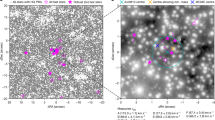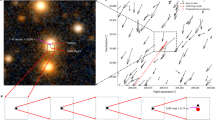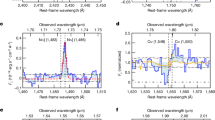Abstract
Intermediate-mass black holes should help us to understand the evolutionary connection between stellar-mass and super-massive black holes1. However, the existence of intermediate-mass black holes is still uncertain, and their formation process is therefore unknown2. It has long been suspected that black holes with masses 100 to 10,000 times that of the Sun should form and reside in dense stellar systems3,4,5,6. Therefore, dedicated observational campaigns have targeted globular clusters for many decades, searching for signatures of these elusive objects. All candidate signatures appear radio-dim and do not have the X-ray to radio flux ratios required for accreting black holes7. Based on the lack of an electromagnetic counterpart, upper limits of 2,060 and 470 solar masses have been placed on the mass of a putative black hole in 47 Tucanae (NGC 104) from radio and X-ray observations, respectively8,9. Here we show there is evidence for a central black hole in 47 Tucanae with a mass of  solar masses when the dynamical state of the globular cluster is probed with pulsars. The existence of an intermediate-mass black hole in the centre of one of the densest clusters with no detectable electromagnetic counterpart suggests that the black hole is not accreting at a sufficient rate to make it electromagnetically bright and therefore, contrary to expectations, is gas-starved. This intermediate-mass black hole might be a member of an electromagnetically invisible population of black holes that grow into supermassive black holes in galaxies.
solar masses when the dynamical state of the globular cluster is probed with pulsars. The existence of an intermediate-mass black hole in the centre of one of the densest clusters with no detectable electromagnetic counterpart suggests that the black hole is not accreting at a sufficient rate to make it electromagnetically bright and therefore, contrary to expectations, is gas-starved. This intermediate-mass black hole might be a member of an electromagnetically invisible population of black holes that grow into supermassive black holes in galaxies.
This is a preview of subscription content, access via your institution
Access options
Access Nature and 54 other Nature Portfolio journals
Get Nature+, our best-value online-access subscription
$29.99 / 30 days
cancel any time
Subscribe to this journal
Receive 51 print issues and online access
$199.00 per year
only $3.90 per issue
Buy this article
- Purchase on SpringerLink
- Instant access to full article PDF
Prices may be subject to local taxes which are calculated during checkout




Similar content being viewed by others
References
Volonteri, M. The formation and evolution of massive black holes. Science 337, 544–547 (2012)
Baumgardt, H., Makino, J. & Hut, P. Which globular clusters contain intermediate-mass black holes? Astrophys. J. 620, 238–243 (2005)
Sigurdsson, S. & Hernquist, L. Primordial black holes in globular clusters. Nature 364, 423–425 (1993)
Ebisuzaki, T. et al. Missing link found? The “runaway” path to supermassive black holes. Astrophys. J. 562, L19–L22 (2001)
Miller, M. C. & Hamilton, D. P. Production of intermediate-mass black holes in globular clusters. Mon. Not. R. Astron. Soc. 330, 232–240 (2002)
Maccarone, T. J., Kundu, A., Zepf, S. E. & Rhode, K. L. A black hole in a globular cluster. Nature 445, 183–185 (2007)
Strader, J. et al. No evidence for intermediate-mass black holes in globular clusters: strong constraints from the JVLA. Astrophys. J. 750, L27 (2012)
De Rijcke, S., Buyle, P. & Dejonghe, H. Upper limits on the central black hole masses of 47Tuc and NGC 6397 from radio continuum emission. Mon. Not. R. Astron. Soc. 368, L43–L46 (2006)
Grindlay, J. E., Heinke, C., Edmonds, P. D. & Murray, S. S. High-resolution X-ray imaging of a globular cluster core: compact binaries in 47Tuc. Science 292, 2290–2295 (2001)
Freire, P. C. et al. Further results from the timing of the millisecond pulsars in 47 Tucanae. Mon. Not. R. Astron. Soc. 340, 1359–1374 (2003)
Ridolfi, A. et al. Long-term observations of the pulsars in 47 Tucanae — I. A study of four elusive binary systems. Mon. Not. R. Astron. Soc. 462, 2918–2933 (2016)
Pan, Z. et al. Discovery of two new pulsars in 47 Tucanae (NGC 104). Mon. Not. R. Astron. Soc. 459, L26–L30 (2016)
Phinney, E. S. Pulsars as probes of Newtonian dynamical systems. Phil. Trans. R. Soc. Lond. A 341, 39–75 (1992)
Baumgardt, H. N-body modeling of globular clusters: masses, mass-to-light ratios and intermediate-mass black holes. Mon. Not. R. Astron. Soc. 464, 2174–2202 (2017)
McLaughlin, D. E. et al. Hubble Space Telescope proper motions and stellar dynamics in the core of the globular cluster 47 Tucanae. Astrophys. J. Suppl. Ser. 166, 249–297 (2006)
Watkins, L. L., van der Marel, R. P., Bellini, A. & Anderson, J. Hubble Space Telescope Proper Motion (HSTPROMO) catalogs of galactic globular clusters. II. Kinematic profiles and maps. Astrophys. J. 803, 29 (2015)
Pfahl, E., Rappaport, S. & Podsiadlowski, P. A comprehensive study of neutron star retention in globular clusters. Astrophys. J. 573, 283–305 (2002)
Ivanova, N., Heinke, C. O., Rasio, F. A., Belczynski, K. & Fregeau, J. M. Formation and evolution of compact binaries in globular clusters — II. Binaries with neutron stars. Mon. Not. R. Astron. Soc. 386, 553–576 (2008)
Bahcall, J. N. & Wolf, R. A. Star distribution around a massive black hole in a globular cluster. Astrophys. J. 209, 214–232 (1976)
Smith, G. H. Globular cluster winds driven by main-sequence stars. Publ. Astron. Soc. Pacif. 111, 980–985 (1999)
Scott, E. H. & Durisen, R. H. Nova-driven winds in globular clusters. Astrophys. J. 222, 612–620 (1978)
Coleman, G. D. & Worden, S. P. Large-scale winds driven by flare-star mass loss. Astrophys. J. 218, 792–800 (1977)
Spergel, D. N. Evacuation of gas from globular clusters by winds from millisecond pulsars. Nature 352, 221–222 (1991)
Freire, P. C. et al. Detection of ionized gas in the globular cluster 47 Tucanae. Astrophys. J. 557, L105–L108 (2001)
Giersz, M., Leigh, N., Hypki, A., Lützgendorf, N. & Askar, A. MOCCA code for star cluster simulations — IV. A new scenario for intermediate mass black hole formation in globular clusters. Mon. Not. R. Astron. Soc. 454, 3150–3165 (2015)
Soria, R. et al. Super-Eddington mechanical power of an accreting black hole in M83. Science 343, 1330–1333 (2014)
Portegies Zwart, S. F., Baumgardt, H., Hut, P., Makino, J. & McMillan, S. L. W. Formation of massive black holes through runaway collisions in dense young star clusters. Nature 428, 724–726 (2004)
Morscher, M., Pattabiraman, B., Rodriguez, C., Rasio, F. A. & Umbreit, S. The dynamical evolution of stellar black holes in globular clusters. Astrophys. J. 800, 9 (2015)
Alexander, T. & Natarajan, P. Rapid growth of seed black holes in the early universe by supra-exponential accretion. Science 345, 1330–1333 (2014)
Richstone, D. et al. Supermassive black holes and the evolution of galaxies. Nature 395, A14–A19 (1998)
Camilo, F., Lorimer, D. R., Freire, P., Lyne, A. G. & Manchester, R. N. Observations of 20 millisecond pulsars in 47 Tucanae at 20 centimeters. Astrophys. J. 535, 975–990 (2000)
Freire, P. C. et al. Timing the millisecond pulsars in 47 Tucanae. Mon. Not. R. Astron. Soc. 326, 901–915 (2001)
Aarseth, S. J. From NBODY1 to NBODY6: The growth of an industry. Publ. Astron. Soc. Pacif. 111, 1333–1346 (1999)
Nitadori, K. & Aarseth, S. J. Accelerating NBODY6 with graphics processing units. Mon. Not. R. Astron. Soc. 424, 545–552 (2012)
VandenBerg, D. A., Brogaard, K., Leaman, R. & Casagrande, L. The ages of 55 globular clusters as determined using an improved method along with color-magnitude diagram constraints, and their implications for broader issues. Astrophys. J. 775, 134 (2013)
Baumgardt, H., Makino, J., Hut, P., McMillan, S. & Portegies Zwart, S. A dynamical model for the globular cluster G1. Astrophys. J. 589, L25–L28 (2003)
McNamara, B. J., Harrison, T. E., Baumgardt, H. & Khalaj, P. A search for an intermediate-mass black hole in the core of the globular cluster NGC 6266. Astrophys. J. 745, 175 (2012)
Jalali, B. et al. A dynamical N-body model for the central region of ω Centauri. Astron. Astrophys. 538, A19 (2012)
Harris, W. E. A catalog of parameters for globular clusters in the Milky Way. Astron. J. 112, 1487 (1996)
Harris, W. E. A new catalog of globular clusters in the Milky Way. Preprint at https://arxiv.org/abs/1012.3224 (2010)
Baumgardt, H., Makino, J. & Ebisuzaki, T. Massive black holes in star clusters. II. Realistic cluster models. Astrophys. J. 613, 1143–1156 (2004)
Goodman, J. & Hut, P. Primordial binaries and globular cluster evolution. Nature 339, 40–42 (1989)
Giersz, M. & Heggie, D. C. Monte Carlo simulations of star clusters — VII. The globular cluster 47 Tuc. Mon. Not. R. Astron. Soc. 410, 2698–2713 (2011)
Lützgendorf, N., Baumgardt, H. & Kruijssen, J. M. D. N-body simulations of globular clusters in tidal fields: effects of intermediate-mass black holes. Astron. Astrophys. 558, A117 (2013)
Hurley, J. R., Pols, O. R. & Tout, C. A. Comprehensive analytic formulae for stellar evolution as a function of mass and metallicity. Mon. Not. R. Astron. Soc. 315, 543–569 (2000)
Albrow, M. D. et al. The frequency of binary stars in the core of 47 Tucanae. Astrophys. J. 559, 1060–1081 (2001)
Kullback, S. & Leibler, R. A. On information and sufficiency. Ann. Math. Stat. 22, 79–86 (1951)
Kiziltan, B. & Thorsett, S. E. Constraints on pulsar evolution: the joint period-spin-down distribution of millisecond pulsars. Astrophys. J. 693, L109–L112 (2009)
Guhathakurta, P., Yanny, B., Schneider, D. P. & Bahcall, J. N. Globular cluster photometry with the Hubble Space Telescope. I — Description of the method and analysis of the core of 47 Tuc. Astron. J. 104, 1790–1817 (1992)
Calzetti, D., de Marchi, G., Paresce, F. & Shara, M. The center of gravity and density profile of 47 Tucanae. Astrophys. J. 402, L1–L4 (1993)
Acknowledgements
This work was supported in part by the Black Hole Initiative at Harvard University, through the grant from the John Templeton Foundation.
Author information
Authors and Affiliations
Contributions
B.K. initiated the project, led the collaboration, and wrote the manuscript. H.B. calculated the N-body models. A.L. made contributions to the conceptual definition of the project. All authors contributed to the analysis.
Corresponding author
Ethics declarations
Competing interests
The authors declare no competing financial interests.
Extended data figures and tables
Extended Data Figure 1 Cluster surface brightnesses and corresponding neutron star spatial distributions in N-body models for projected half-light radii.
The solid, dashed and dotted lines represent N-body models with an IMBH, with and without primordial binaries, respectively. a, All models have roughly comparable surface brightnesses; in contrast, b, the distribution of neutron stars is notably different for the IMBH model. The neutron star spatial distributions for N-body simulations with and without primordial binaries are similar. Therefore, it is unlikely that primordial binaries play a considerable role in shaping the final segregation profile of clusters with an IMBH.
Extended Data Figure 2 Comparison of the observed and predicted pulsar accelerations.
The observed acceleration (shaded areas) for each pulsar (named at the top of each panel) in 47 Tuc is compared with the integrated acceleration distributions for pulsars with the same line-of-sight distance predicted from N-body simulations (solid line, models with IMBH; dashed line, model without IMBH). The KL divergence method is used to calculate the integrated information entropy between distributions (equation (1)). The shaded areas show the 68%, 95% and 99% range of possible accelerations experienced owing to the gravitational potential of the cluster. Darker shades represent higher probability. The ambiguity is largely due to the unknown intrinsic spin-down of individual pulsars.
Extended Data Figure 3 Predictive power correlates with number of observed pulsars.
Shown are the normalized probabilities of N-body models with different black hole masses, as in Fig. 4a, for different numbers of randomly selected pulsars. The converging inference with increasing number of pulsars is indicative of statistical learning and demonstrates that the information comes from observations. The line thickness scales with the level of ambiguity for each inference.
Rights and permissions
About this article
Cite this article
Kızıltan, B., Baumgardt, H. & Loeb, A. An intermediate-mass black hole in the centre of the globular cluster 47 Tucanae. Nature 542, 203–205 (2017). https://doi.org/10.1038/nature21361
Received:
Accepted:
Published:
Issue Date:
DOI: https://doi.org/10.1038/nature21361



